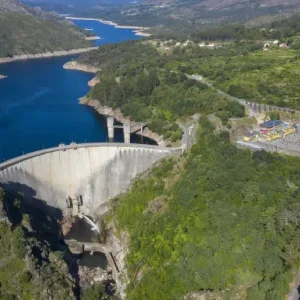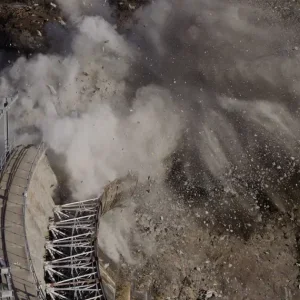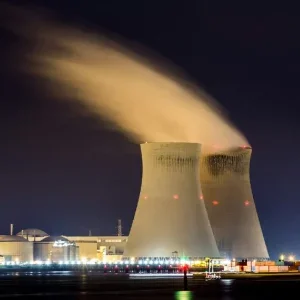The upstream cushion zone in a concrete face rockfill dam (CFRD) provides support to the concrete slabs on the face of the dam. Its composition is such that when it is in place adjacent to a perimeter joint or underneath a face slab the material limits and controls leakage, in the event of a local malfunction at a joint. In recent years the requirements for material in the cushion zone have been stated as follows:
•Semi pervious, with a coefficient of permeability of 10-3-10-4cm/sec.
•Non-erodible, to avoid rainfall erosion before the slabs are put in place.
•A high modulus of compressibility.
•Average content of fines passing a No4 sieve (5mm) 40%.
•Content of fines passing a No200 sieve 2-12%.
•Free of significant segregation.
From the last 20 years experience, cushion zone material may be from quarried fine rock with no removal of sand and small rocks (as at Cethana), from crushed rock (as at Foz do Areia, Cirata, Segredo or Tianshenqiao 1), or from grizzled weathered rock (Xingo).
When the cushion zone rock is obtained from crushed rock with a low percentage of fines, the requirement to obtain an average content of 40% 5mm fines is likely to increase costs slightly, as fines must be added to the crusher-run product. However, the cost increase is compensated by improved quality. Good examples are the cases of Foz do Areia and Segredo, where the crushed basalt rock lacks good fines content. In these two dams cushion zones were built using crusher-run with a low percentage of fines. Cushion zones using alluvial gravel generally need crushing, and eventually mixing, to obtain suitable gradation, since alluvial gravel deposits are often heterogeneous and would not contain a sufficiently high content of fines, as at Salvajina, Golillas and Aguamilpa, (see Colombian experience with concrete face rockfill dams, IWP&DC, January 1991).
Materials with more fines are more easily placed, spread and compacted than rockfill with larger particles or blocks. The higher is the non-uniformity coefficient, the better are the compaction results. However, the maximum particle size must be specified to avoid segregation during handling and operation work. At Cethana the specification allowed the use of any quarried hard rock with a maximum size smaller than 9in, except materials with significant soil fines smaller than a No200 sieve. Maximum particle sizes in cushion zones in Colombia vary from 12in at Alto Anchicaya (completed in 1974), to 6in at Golillas (1978), and 4in at Salvajina (1984). In recent CFRDs maximum particle sizes of 3in have been adopted for cushion zones. In Tianshenqiao 1 (TSQ 1) the design specification asks for a maximum particle size of 3in, and most placed material was smaller than 2in.
Compaction requirements, such as layer depth and compaction energy, have not greatly changed over the past 20 years. Layer thickness varies from 40cm to 50cm. Horizontal compaction is accomplished by four passes of a 10t smooth drum vibratory roller, followed by slope compaction by a 5t smooth drum roller vibrating in the up slope direction. In recent CFRDs, a plate vibrator mounted in an excavator or backhoe is used for slope compaction near the plinth and for horizontal compaction of the filter zone and cushion zone near the plinth edge. This equipment was first used by Japanese contractors at Batang Ai, which was completed in 1985.
Experience at TSQ 1
China’s TSQ 1 project is on the Nanpan river, on the borders of Guangxi and Guizhou. The dam is 178m high with a crest length of 1168m, and it has an installed capacity of 1200MW. The project was designed by the Kunming Hydropower Design Institute, and the CFRD and spillway construction has been carried out by South Hydropower Construction Association Ltd, which is a joint venture of Chinese Jiangnan Water Resources & Hydropower Construction and Brazilian contractor Mendes Junior Engenharia.
The total embankment volume is 17.7Mm3, and the slab has a total area of 180,000m2, and a volume of 900,000m3. This is being placed in three stages: the first and second have already been completed. By November 1998 around 80% of the total embankment had been completed — 14.7M m3 of rockfill had been placed and 75% of the face slab concrete works had been completed. The third stage began in early 1999.
The gradation specified for the cushion zone at TSQ 1 fits the modern trend of using well-graded sandy gravel, with a high fines content. From the early stages of the design the gradation was expected to include a high percentage of cohesionless fines, if blending was required. This was supported by research (Keming, Cao, Journal of Geotechnical Engineering, Vol 113 No 10, ASCE October 1987). The specified maximum particle size was 80mm, with 25-50% smaller than 5mm and 2-5% smaller than 0.076mm. The same material, but with particles above 40mm removed, was specified for the filter zone, immediately behind the perimeter joint, to protect the coal ash and fine silty sand placed upstream of the joint.
In practice the crusher run at TSQ 1 was slightly finer than the expected material, with a maximum diameter of around 50mm. The material therefore fulfilled the criteria for coal ash and it was also used in the filter zone. Up to a height of 62m filter zone material was produced specially, according to the specifications. Above that elevation, the filter zone was built using the same crusher run as the cushion zone, ensuring that coarse segregated particles were removed in areas close to the perimeter joint.
Placement was carried out by dumping and spreading in layers 3m wide and 0.4m deep, followed by compaction using a vibratory roller (18t Bomag or Ingersoll Rand rollers). The face was compacted using a vibrating 9t roller pulled upwards along the slope by a crane.
The routine sequence for upstream embankment construction was:
•Place a transition layer 5m wide and 0.4m deep.
•Remove the coarse segregated blocks at the upstream edge.
•Place a cushion zone layer, 3m wide and 0.4m deep.
•Place a layer of rockfill (zone IIIB) 0.8m deep.
The crusher run was placed to an excess width of 0.4-0.5m, compared to the specification. The cushion and transition zones were compacted with six passes of the 18t smooth drum vibratory roller. After compaction excess material was trimmed and removed, at 4-5m height, with a Gradall telescopic backhoe. It was incorporated into the next layer.
Because of the shortage of cushion material, above el 762 the cushion zone was 2m wide, with compensation provided by a transition zone 6m wide.
The upstream slope was treated by compacting and sealing the slope surface.
The slope was first compacted by eight passes of a 9t smooth vibratory roller operated by a crane: four downward passes without vibration and four upward passes with full vibration. Compaction was improved by light water sprinkling before compaction. According to the construction schedule this method requires 20-25m of slope length for the roller to work. The 2m at the top of the slope, not covered by the 9t roller, was compacted with a plate vibrator mounted on a backhoe. Restricted areas where the rollers would not work were compacted using the plate vibrator.
Secondly, asphalt was sprayed in two applications up to el 682 (the first stage slabs) and three applications from el 682 to el 746 (the second stage slabs). Fine sand was spread after each application, but no more compaction was carried out. In particular places, such as the abutment edges below el 682 and a few meters above el 746 (above the second stage slabs) mortar lining was placed by hand.
A barrier of sand bags 0.6m high was placed temporarily along the upstream edge of the cushion zone.
Significant erosion of the cushion zone upstream slope occurred once, in restricted areas, during the 1997 wet season. A gully around 2m deep and 2m wide was eroded at a lower part of the slope, and was treated by removing the loosened material, backfilling, and compacting in 0.1m layers using a manual compactor. Additional compaction was provided afterwards using the 9t roller.
In-situ density tests and laboratory grading tests were carried out by the contractor’s laboratory for every 2000m3 of cushion zone placed material. The field density tests were performed by using a 0.5m diameter metallic ring in the horizontal layers and by using the sand method (cone device) at the upstream slope. There were also in-situ and laboratory permeability tests.
Between May 1996 and November 1998 195 density tests found an average value of 2.27g/cm3 (specification 2.2g/cm3) and moisture content from 1% in dry seasons to 10% in flood seasons.
The permeability of the TSQ1 crusher run material varies from 7×10-3 to 1.5×10-2 cm/sec, (the figure considered most desirable by Sherard would be less than 1×10-3 g/cm). This crusher run is therefore not the ideal semi pervious material, but it is fully satisfactory when compared with materials used in other CFRDs. Permeability of 1×10-3 cm/sec is found only in fine silty sand and in coal ash, which is applied as clogger material over the perimeter joint.
Observations and notes
The cushion zone at TSQ1 meets with the modern concept of a semi-pervious barrier against any leakage through the slabs. The production required simple crushing and washing operations, and there was no need for any blending, but there were shortages during the second stage construction. Placement, protection and compaction were satisfactory, and a telescopic backhoe (Gradall) and 18t vibratory roller were used.
Some useful observations were made:
•In cases like TSQ 1, where the cushion zone is compacted horizontally in excess, the trimmed slope surface exposes material that has been compacted horizontally. A slope that has been compacted using a 9t vibrating roller is not as strong as horizontal compaction by an 18t roller, and will not improve the density and modulus of the material, except for the few centimetres depth that have been loosened by the backhoe bucket. The additional settlement of these few centimetres is negligible: one-pass coverage, using the 9t roller, would suffice, and would be simpler and faster.
•An interesting peculiarity occurred in the upstream slope surface when an opening was observed between the concrete slab crest and the cushion zone at el 680. The first stage face slab reached el 680 in May 1997 and embankment construction went on up to el 748 (by February 1998). An inspection, before construction of the second stage concrete slabs, showed an opening between the slab wedge at el 680 and the slope surface of the cushion zone. Surveys indicated that the opening was along almost all the face slab wedge, varying up to 15cm wide and 7m depth. The opening was grouted before the second stage face slabs were concreted. A similar opening had been seen at Xingo and was similarly treated by grouting. The opening is a feature which may occur in most high dams where concrete slabs are added in stages; filling the opening with grout may be the simplest and easiest way of solving the problem.
•The upstream slope surface of the cushion zone presented settlement, caused by embankment loading along the entire slope. The settlements varied up to 50cm. Following the instructions of the engineer and the designer, compensation was made by placing extra cushion material on the slope surface, restoring the design line. The material was lowered and spread by hand, and compacted by vibratory roller. Around 20,000m3 of extra material was placed, delaying slab construction by more than one month. This requirement is time consuming, costly, and meaningless for dam behaviour.
•The cushion zone close to the plinth was founded at el 613 on sound river bed rock. The water for rockfill wetting works during placement and compaction, rainfall water and water from the abutments’ natural ground water table could be trapped in the upstream side, as the river level near the dam axis and downstream was 4m higher. The lower permeability of the cushion zone could promote an increase in the water level on the upstream rockfill, risking the cushion zone and concrete slabs. A temporary drainage system was built in the lower upstream embankment, comprising six horizontal 6in diameter steel pipe drains laid above the plinth, and a pumping drainage shaft (1.2m diameter and 25m deep) from the rock foundation crossing the upstream slope face. A pumping system was used to support gravity drainage, as the horizontal pipes suffered partial clogging with rock fines. All pipes and shafts were later plugged.
•The use of crusher run material from limestone that complies with modern grading criteria can achieve good compaction and construction conditions for the cushion zone. This very appropriate material, with plenty of fines, can be obtained in a crushing plant without costly mixing and blending. Depending on the quarried rock, even a simple and less costly grizzlying plant may produce suitable material.
•For high CFRDs, if the same crusher is expected to provide both cushion zone material and aggregates for concrete, the construction schedule should be carefully considered. Cushion zone material should be stockpiled to avoid materials shortages and delays in concrete construction.
•Slope surface protection is important to avoid erosion: repair must always be completed in difficult conditions and compaction is never as good as routine compaction. In countries where manpower has a low cost, hand-placed mortar may be a competitive method, rather than shotcrete or asphalt emulsion.
Related ArticlesSpotlight on… CFRD






